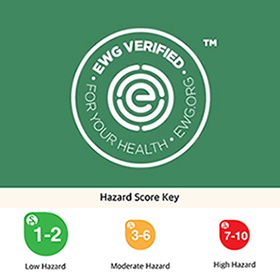1. What is an EWG rating?
EWG is an abbreviation of Environmental Working Group and was created in 1992 by a non-profit environmental organization in Washington, USA for human health and the environment. In this organization, the objective database for product safety is called the EWG rating, and it is divided into 1 to 10 levels, which is called the EWG rating. The lower the number of grades, the safer it belongs. Among them, grades 1 to 2 are indicated in green as safety levels, and grades 3 to 6 are indicated in yellow because they contain moderately harmful substances. And 7 to 10 grades represent hazardous ingredients with high harmfulness and are expressed in red.
2. Are all EWG grade 1~2 safe ingredients?


The EWG rating consists of the ‘hazard class’ and ‘data class’. Please refer to the photo above.
The grade marked with the colour we know means ‘hazard grade’, and ‘data grade’ means how much data on hazards are available.
‘Data grade’ consists of a total of five levels: None / Limited / Fair / Good / Robust.
Most of the ‘hazard level’ is considered to be safe if it is green, but if you look at the image above, the ‘data level’ is different even if it is the same grade 1 ingredient.
If the data is at the ‘Robust’ level, it means that there are enough reliable data, and at the ‘None’ level, it means that there is no data on harmfulness.
Therefore, it is recommended that you check the ‘hazard grade’ of products with insufficient data for ‘data grade’ from time to time because the grade may change in the future.
Carefully look at both data to choose a reliable and safe ingredient.
3. Is the EWG rating a perfect indicator?
EWG ratings help select safe ingredients but are a reference tool and not an absolute criterion. Also, rather than recognizing that chemical ingredients are not unconditionally good, I think it is important to find ingredients that do not suit me. In fact, if you listen to the stories of manufacturers, it is said that even the ingredients that must be added for the stability of cosmetics are not well recognized by consumers, making the manufacturing process more complicated than necessary.
Some manufacturers configure and sell green grades according to consumer demand, but the safety of the product is not guaranteed.
My personal opinion is that rather than just looking at the presence or absence of harmful ingredients, we should also look at what kind of ingredients are contained.
Also, please refer to information from organizations such as INCI (International NomenclatureCosmetic Ingredient), which provides indicators of ingredient safety rather than trusting one indicator, and find reliable information among various information and utilize the raw materials that suit your situation.
-The Nature Atelier-
If my article was helpful, please comment and visit my SNS. It will be a great help for me to continue running the site.
Twitter
https://twitter.com/Atelier_Eden
Instagram
https://www.instagram.com/the.natureatelier
